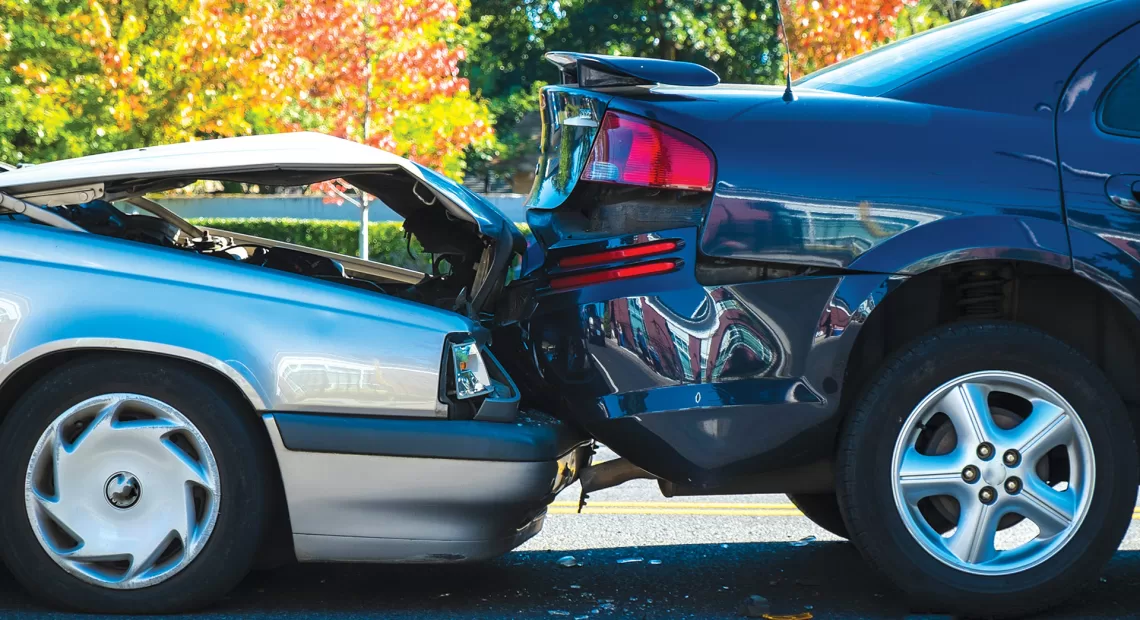Driving Up the Cost

Wondering why auto insurance is much more expensive now than it was a couple of years ago? You’re not alone.
There are a number of reasons why, but Joe Phillips starts with an unprecedented series of changes in driver behavior brought on by COVID-19.
“Companies started adopting safe-driver points and rebate offers, and when 2020 hit, everyone stopped driving, they stayed home, nobody was going to school, the roads were empty, and people got a lot of money back because accidents were way down,” said Phillips, president of Phillips Insurance Agency in Chicopee.
“That situation, with less activity, went on for more than two years: a reduction in driving, reduction in accidents, lower repair costs,” he went on. “But in late ’22, 2023, more people were back to work, everyone was back to school, distracted driving is on the rise, and claims have gone through the roof.”
John Dowd, president and CEO of the Dowd Agencies in Holyoke, said an increase in accidents after the pandemic caught insurance companies “flat-footed.”
“Insurance companies set their rates in advance for the year; they have to file with the state. So by the time claims started coming in and hitting their books, they could see that they were underwater in terms of seeing a profit.”
“Insurance companies set their rates in advance for the year; they have to file with the state,” he explained. “So by the time claims started coming in and hitting their books, they could see that they were underwater in terms of seeing a profit. So they’ve reacted to that, and this past year, the rates went up significantly.”
“So they’ve reacted to that, and this past year, the rates went up significantly — and in this current year, it’s still going on,” he continued. “It’s a challenge for brokers like ourselves; we’re getting quotes from different companies to try to mitigate some of these increases, but we’re finding they’re all pretty much raising the rates. It’s not isolated.”
Dowd explained a concept well-known in the insurance world, but perhaps not to many customers: the loss ratio. The break-even figure is 100%, meaning that, for every dollar a carrier collects in premiums, it’s paying that much back in claims and administrative costs.
“So, obviously they want to be at least a few points under that to be able to make a profit,” he said. “On the automotive line alone, we’re seeing loss ratios of 110%, 115%. When that happens, they have no choice but to raise their rates because these losses eat into their profits and cause all kinds of problems for companies.”
Why they got caught flat-footed is a story with several different factors, which Dowd and Phillips shared with BusinessWest for this issue’s focus on insurance.
Parts of the Problem
Among the ways the pandemic has continued to affect the insurance world are two terms everyone is weary of by now: inflation and supply chain.
“When you’ve got a damaged car and you have supply-chain problems because of COVID, you can’t get parts, and then you had a stimulus from the federal government that just caused inflation. So now you can’t get a part, and they’re more expensive, so these claims have gone through the roof,” Phillips said, citing electric vehicles in particular. He noted that the average cost to repair the bumper of a Rivian electric truck after a collision is $4,200, and the Tesla is the most expensive car to insure in the U.S.
Joe Phillips
“When you’ve got a damaged car and you have supply-chain problems because of COVID, you can’t get parts, and then you had a stimulus from the federal government that just caused inflation.”
Dowd agreed. “All the technology is more expensive. What used to be a $1,500 bumper repair is now $2,500, and that’s because of the sensors. It looks like there’s not much damage, but when you have to replace all the sensors, all of a sudden, you’re asking, ‘how did this bill escalate to this level? It didn’t look like that much damage to me.’ But it was in a bad spot where you had to replace the sensors.”
Beyond the availability and complexity of parts is the sophistication of technicians themselves, who understand the electronics in today’s high-tech cars, Dowd added. “With a lot of technologies built in, the technicians that do these repairs have to be trained properly, and there’s a shortage of them. So it’s the cost of products and labor, it’s the availability, the supply chain, qualified technicians … they’re sort of coming together at once.”
And it’s no myth that accidents are up, Phillips added. “The distracted driving is huge. Not to sound like the old guy, but these kids can’t put their phones down. When you get to a stop sign, you see these young people getting on their phone for 15 seconds, and you have to beep at them. And then the reaction … oh boy.”
Severe weather events in recent years have also played a part in rising insurance rates for every type of coverage, from home and auto to commercial, he noted.
“It’s a real confluence of things coming together to create almost a perfect storm,” Dowd added. On one hand, everyone knows about inflation and what that’s done to prices, whether at the grocery store, the gas pump, anywhere. The cost of parts to repair cars, the cost of materials to repair homes, everything has gone up, and it’s gone up in rather a dramatic fashion over the last 12 to 18 months.”
He noted that inflation has begun to wane, “but there still supply-chain challenges, and that creates delays getting parts, which creates delays in getting the car back, which means you’ve got to rent a car … these are all ripple effects of what’s going on.”
And it’s caused concern in the insurance industry, Phillips said, as evidenced by recent waves of layoffs at national carriers like GEICO and Liberty Mutual. “They’re not making the money they once did because of increased claims.”
Meanwhile, Dowd said, the retail market — which is the realm in which he and other local agencies deal with clients — is being pressured by the reinsurance market, which, as the name suggests, is populated by companies that reinsure much of the risk from retail carriers, which pay a premium to the reinsurer to limit their exposure to catastrophic loss.
“The reinsurance market has been tested financially in the last couple of years, like they haven’t been in a long time,” he explained. “Judgments are higher, the juries are awarding higher payouts to injured people, and it’s starting to get into the reinsurance layer, so the reinsurers have raised their rates; they charge their retail carriers higher premiums, and the retail carriers pass along some of these increases to their customers. For us, that’s another factor.”
With weather events alone contributing to $95 billion in insurance claims last year, much paid out by reinsurers, Dowd said, “they’re scrambling to make their profit.”
Risk and Reward
In short, there’s a lot going on, and it’s not a Massachusetts problem, Dowd said. “It’s a nationwide issue, and as brokers, we’re the ones that have to deliver the bad news. We certainly understand the level of concern the customers have, and we don’t want to deliver that news any more than they want to hear it.
John Dowd
“The reinsurers have raised their rates; they charge their retail carriers higher premiums, and the retail carriers pass along some of these increases to their customers.”
“We’re doing the best to find alternatives for them to keep increases to a minimum; sometimes we can, but sometimes we can’t,” he went on. “Every change you make to a policy to try to reduce cost, whether a huge deductible or less coverage, it’s all a gamble. It’s like going to the casino. When you take on a higher deductible or reduced coverage, you’re betting on not having a claim. And that can work for you, but it can work against you.”
Phillips agreed. “Everyone wants the lowest cost until they have a claim. When people come in for a quote, they say, ‘I don’t need that, I don’t need this.’ And when they have a claim, they say, ‘oh, I definitely would have taken that.’ Well, it would have only cost $32 a year.
“We never sell the lowest limits,” he went on, but sometimes clients will insist on saving a couple hundred dollars to raise a $500 deductible into the four-figure range. “People think they can tolerate a $2,000 collision deductible until they have the accident.”
Those who want to keep their costs down should not only shop prices, Phillips added, but be aware of their credit score and their driving record — “even a failure to stop or a speeding ticket can add hundreds of dollars of premium” — but also be aware of the type and make of the vehicle they buy, which greatly impacts coverage, based on average theft rate and repair costs.
Dowd said certain people, who have a long track record of safe driving, may be fine taking a higher deductible.
“There’s obviously no guarantee. And if you take the savings and take a little more risk, you still need the catastrophic protection in case something serious happens,” he stressed. “You don’t want to cut into the muscle of the coverage where the catastrophic protection isn’t there, which can really hurt people financially.”
After all, insurance is all about protecting against the most severe losses — even if purchasing it makes a bigger dent than it used to.









